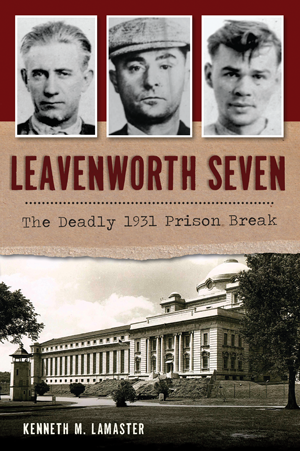
Striking images of the murderers, robbers, and swindlers who orchestrated a complex prison break from the infamous Leavenworth Prison in 1931
More mug shots, you say? Another serving of ravishing rascals, you ask? Our friends from Sacramento and from Alabama just weren’t enough to satisfy your appetite? Well, friends, hunger no more. Crime Capsule has another round of eye-catching criminals just for you!
Hailing this time from the great state of Kansas, home to the Leavenworth Federal Prison, these tasty murder morsels can all be found in Kenneth M. Lamaster’s book Leavenworth Seven: The Deadly 1931 Prison Break. In his account, Lamaster tells the full story of one of the most violent jailbreaks in American history, complete with arms smuggling, bribery, hostages, dynamite, gangsters, and getaway cars—the works. Lamaster would know: before he became an author, he was a correctional officer there.

So: on to some of Leavenworth’s most hardened inhabitants. Feast your eyes!
Ricardo Flores Magón

Ricardo Flores Magón. Courtesy National Archives and Records Administration. Magón, Lamaster writes, was in Leavenworth for (among other things) ‘obstruction of military service, violation of the Trading with the Enemy Act, mailing non- mailable matter, and conspiracy.
Bank Robber Frank Nash (1887-1933)

By some accounts, Frank Nash is the most successful bank robber in American history–but he’s most remembered for his dramatic, violent death in the Kansas City Massacre.
Railroad-Robbing Holden-Keating Gang
Thomas James Holden (1896–1953) & Jimmy Keating (1899–1978)

Thomas James Holden and Jimmy Keating were sentenced on April 17, 1928, for the 1926 robbery of the Grand Trunk Railroad mail car in Evergreen Park, Illinois. After securing trusty passes, both men escaped on September 28, 1930. Courtesy National Archives and Records Administration.
“A great story told by a meticulous historian with real-life prison experience.”
– Reader Review of Leavenworth Seven: The Deadly 1931 Prison Break by Kenneth M. LaMaster
Carl Panzram, Serial Killer (1891-1930)

Born in East Grand Forks, Minnesota by the age of six Carl Panzram was already a thief and known liar. At the age of 8, he was in Juvenile Court facing drunk and disorderly charges. Panzram ended up in Leavenworth in 1928 to serve 25 years for burglary, sodomy, and murder. By the end of his life, he confessed to 22 murders and 1,000 instances of sodomy of young boys and men. After multiple imprisonments and escapes, Panzram was put to death in 1930 for the murder of Leavenworth employee Robert Warnke.
Tom Underwood & Stanley Brown

Tom Underwood (left), Stanley Brown (right) and Charlie Berta laying in a ravine shortly after capture. All were returned to the institution. Upon being placed in solitary confinement, Underwood pulled a stick of dynamite from his coat, saying, “I won’t have any use for this anymore.” Courtesy of Kenneth M. LaMaster
Boxcar, Whitey & Durrill

The official death records signed by Ted Sexton indicate Will “Boxcar” Green, George “Whitey” Curtis and Grover C. Durrill all died from self-inflicted gunshots to the head. During the investigation, it was uncovered that at least six of the seven escapees had made a suicide pact to avoid being returned to Leavenworth Penitentiary. Courtesy of Kenneth M. LaMaster.
Machine Gun Kelly

The infamous 1930’s gangster George Kelly Barnes, aka George “Machine Gun” Kelly met his end at Leavenworth Prison. Barnes was an associate of Nash, Holden and Keating and thought to be the unidentified suspect involved in the escape conspiracy. Courtesy National Archives and Records Administration.
Monk Fontaine

Harold “Monk” Fontaine (left) being escorted by an unidentified U.S. Marshal back to the jail in Kansas City, Kansas. Tired of his constant talking, Frank Nash made arrangements with the Boston mob to have Fontaine silenced. Courtesy of the author.




